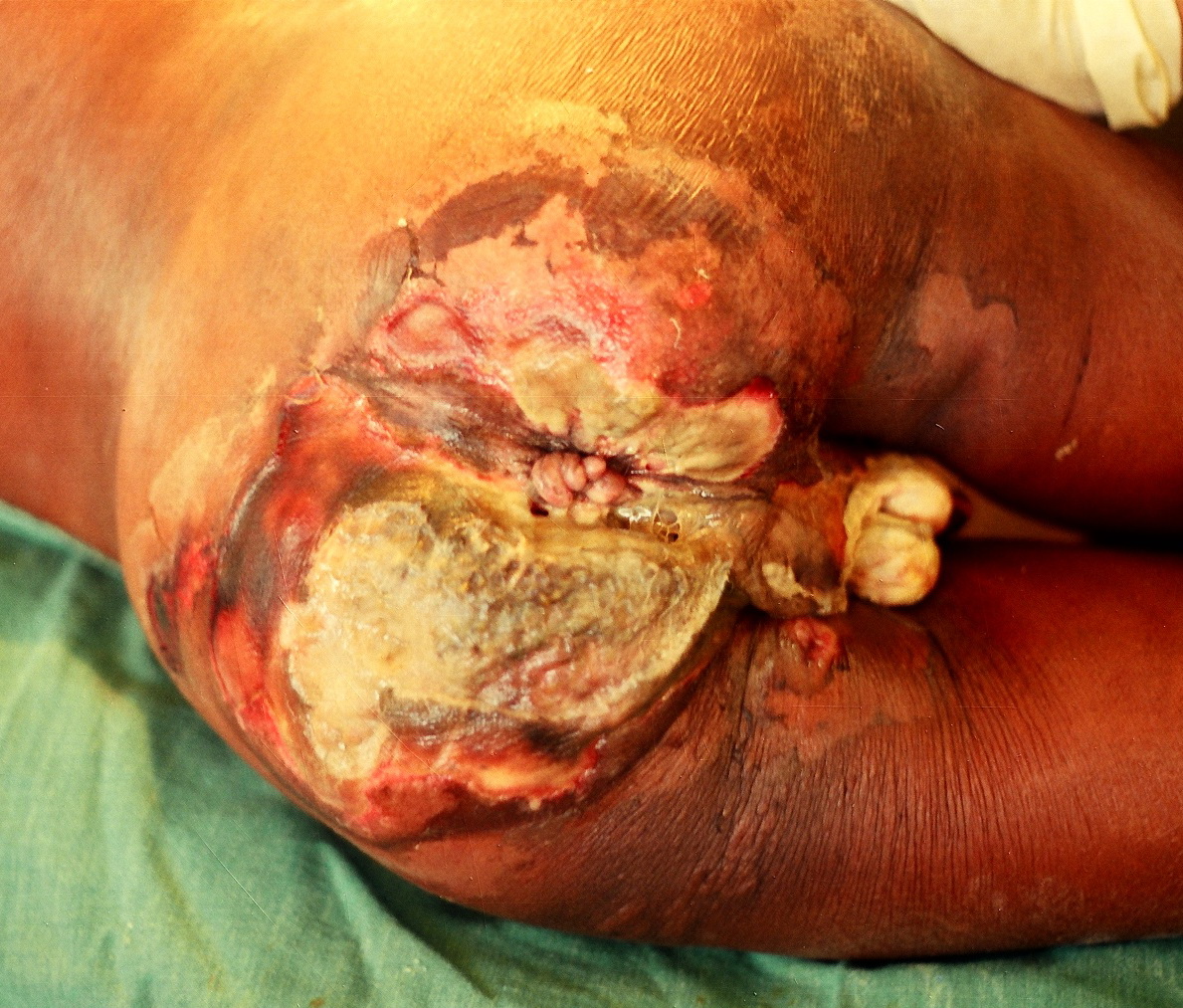
S. pyogenes bacteria @ 900x magnification.
ONE OF THE CAUSES OF NECROTIZING FASCIITIS
WARNING: THE IMAGES BELOW ARE GRAPHIC

Necrotizing fasciitis is a serious bacterial infection that spreads rapidly and destroys the body's soft tissue. Commonly called a "flesh-eating infection" by the media (they destroy the tissue that makes up the skin and muscle by releasing toxins (virulence factors), which include streptococcal pyogenic exotoxins) this rare disease can be caused by more than one type of bacteria. These include group A Streptococcus (group A strep), Klebsiella, Clostridium,E. coli, Staphylococcus aureus, and Aeromonas hydrophila, among others. Group A strep is considered the most common cause of necrotizing fasciitis.
Usually, infections from group A strep bacteria are generally mild or moderate and are easily treated. But sometimes toxins made by these bacteria destroy the tissue they infect, causing it to die. ("Necrotizing" means "causing the death of tissues.") Accurate diagnosis and prompt treatment with antibiotics through a vein and surgery are important.
SOURCES OF INFECTIVE AGENTS
The majority of infections are caused by organisms that normally reside on the individual's skin. These skin flora exist as commensals and infections reflect their anatomical distribution (e.g. perineal infections being caused by anaerobes).
Sources of MRSA may include eating undercooked contaminated meats, working at municipal waste water treatment plants, exposure to secondary wastewater spray irrigation, consuming raw products produced from farm fields fertilized by human sewage sludge or septage, in hospital settings from people with weakened immune systems, or sharing/using dirty needles.
THOSE AT RISK
- Have a weak immune system.
- Have chronic health problems such as diabetes, cancer, or liver or kidney disease.
- Have cuts in your skin, including surgical wounds.
- Recently had chicken pox or other viral infections that cause a rash.
- Use steroid medicines, which can lower the body's resistance to infection.
Over 70% of cases are recorded in people with at least one of the following clinical situations: immunosupression, diabetes, alcoholism/drug abuse/smoking, malignancies, and chronic systemic diseases. For reasons that are unclear, it occasionally occurs in people with an apparently normal general condition.

SYMPTOMS
The infection begins locally at a site of trauma, which may be severe (such as the result of surgery), minor, or even non-apparent. People usually complain of intense pain that may seem excessive given the external appearance of the skin. People initially have signs of inflammation, fever and tachycardia. With progression of the disease, often within hours, tissue becomes progressively swollen, the skin becomes discolored and develops blisters. Crepitus may be present and there may be discharge of fluid, said to resemble "dish-water". Diarrhea and vomiting are also common symptoms.
In the early stages, signs of inflammation may not be apparent if the bacteria are deep within the tissue. If they are not deep, signs of inflammation, such as redness and swollen or hot skin, develop very quickly. skin color may progress to violet, and blisters may form, with subsequent necrosis(death) of the subcutaneous tissues.


TREATMENT
Initial treatment often includes a combination of intravenous antibiotics including piperacillin/tazobactam, vancomycin, and clindamycin. Cultures are taken to determine appropriate antibiotic coverage, and antibiotics may be changed when culture results are obtained.Aggressive surgical debridement (removal of infected tissue) is always necessary to keep it from spreading and is the only treatment available.
Other presentations characterized by massive wounds or tissue destruction, hyperbaric oxygen treatment can be a valuable adjunctive therapy but is not widely available. Amputation of the affected limb(s) may be necessary. Repeat explorations usually need to be done to remove additional necrotic tissue. Typically, this leaves a large open wound, which often requires skin grafting, though necrosis of internal (thoracic and abdominal) viscera – such as intestinal tissue – is also possible.

SURVIVORS OF THIS HORRIFYING DISEASE ARE LEFT WITH DEEP AND DISFIGURING SCARS




SOURCE: WIKIPEDIA
WEBMD.COM
CDC.GOV
wowwwwwwwwwwwww,very informative
ReplyDeleteYikes, I hope I never end up with necrotizing fasciitis, or necrosis in general. That pictured man's who had the necrotic testicles is doomed in one sense. His reproductive system is ruined forever, assuming he survived the ordeal.
ReplyDeleteWell i think i shouldn't have looked this up like omg.
ReplyDeleteI wish i didn't look at this like bruh.
ReplyDeleteWow, thanks for adding something to the conversation, "bruh". I hope you have a swell day, "bruh".
Deletejacksepticeye did say it would make you sick.
ReplyDeletejacksepticeye did say it would make you sick.
ReplyDelete